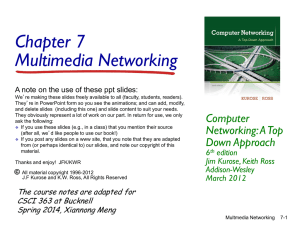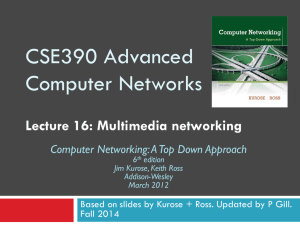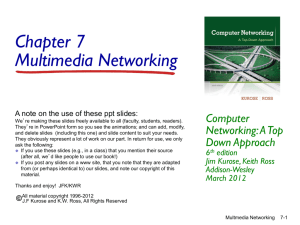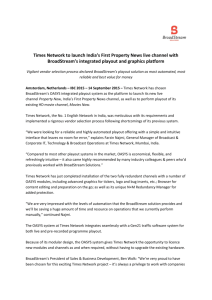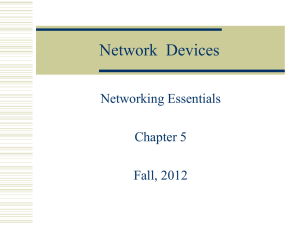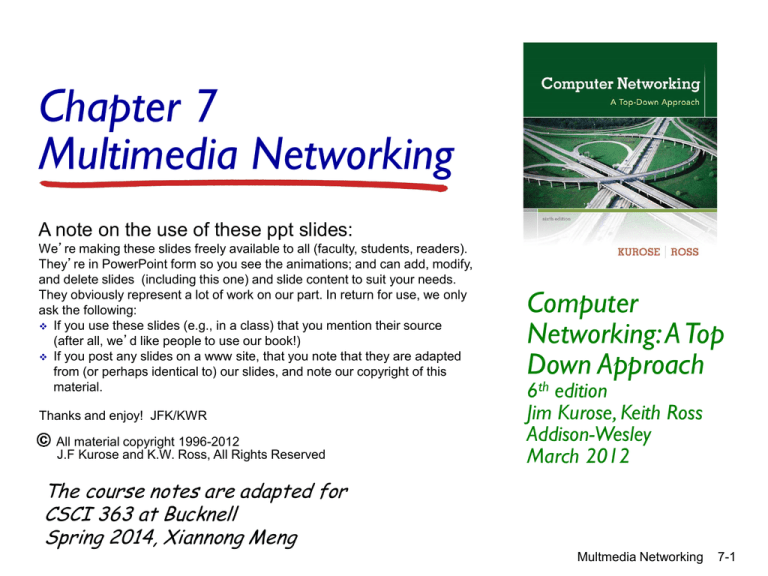
Chapter 7
Multimedia Networking
A note on the use of these ppt slides:
We’re making these slides freely available to all (faculty, students, readers).
They’re in PowerPoint form so you see the animations; and can add, modify,
and delete slides (including this one) and slide content to suit your needs.
They obviously represent a lot of work on our part. In return for use, we only
ask the following:
If you use these slides (e.g., in a class) that you mention their source
(after all, we’d like people to use our book!)
If you post any slides on a www site, that you note that they are adapted
from (or perhaps identical to) our slides, and note our copyright of this
material.
Thanks and enjoy! JFK/KWR
All material copyright 1996-2012
J.F Kurose and K.W. Ross, All Rights Reserved
Computer
Networking: A Top
Down Approach
6th edition
Jim Kurose, Keith Ross
Addison-Wesley
March 2012
The course notes are adapted for
CSCI 363 at Bucknell
Spring 2014, Xiannong Meng
Multmedia Networking
7-1
Multimedia networking: outline
7.1 multimedia networking applications
7.2 streaming stored video
7.3 voice-over-IP
7.4 protocols for real-time conversational
applications
7.5 network support for multimedia
Multmedia Networking
7-2
Multimedia: audio
analog audio signal
sampled at constant rate
telephone: 8,000
samples/sec
music CD : 44,100
samples/sec
each sample quantized, i.e.,
rounded
e.g., 28=256 possible
quantized values
each quantized value
represented by bits,
e.g., 8 bits for 256
values
quantization
error
audio signal amplitude
quantized
value of
analog value
analog
signal
time
sampling rate
(N sample/sec)
Multmedia Networking
7-3
Multimedia: audio
example: 8,000 samples/sec,
256 quantized values: 64,000
bps
receiver converts bits back
to analog signal:
some quality reduction
example rates
CD: 1.411 Mbps (44,100
samples/s, 16 bit/s or 705.6
kbps for mono, 32bit/s or
1.411mbps for stereo)
MP3: 96, 128, 160 kbps
Internet telephony: 5.3 kbps
and up
quantization
error
audio signal amplitude
quantized
value of
analog value
analog
signal
time
sampling rate
(N sample/sec)
Multmedia Networking
7-4
Multimedia: video
video: sequence of images
displayed at constant rate
e.g., 24 images/sec
digital image: array of pixels
each pixel represented
by bits
coding: use redundancy
within and between images
to decrease # bits used to
encode image
spatial (within image)
temporal (from one
image to next)
spatial coding example: instead
of sending N values of same
color (all purple), send only two
values: color value (purple) and
number of repeated values (N)
……………………...…
……………………...…
frame i
temporal coding example:
instead of sending
complete frame at i+1,
send only differences from
frame i
frame i+1
Multmedia Networking
7-5
Multimedia: video
CBR: (constant bit rate): video
encoding rate fixed
VBR: (variable bit rate): video
encoding rate changes as
amount of spatial, temporal
coding changes
examples:
MPEG 1 (CD-ROM) 1.5
Mbps
MPEG2 (DVD) 3-6 Mbps
MPEG4 (often used in
Internet, < 1 Mbps)
spatial coding example: instead
of sending N values of same
color (all purple), send only two
values: color value (purple) and
number of repeated values (N)
……………………...…
……………………...…
frame i
temporal coding example:
instead of sending
complete frame at i+1,
send only differences from
frame i
frame i+1
Multmedia Networking
7-6
Multimedia networking: 3 application types
streaming, stored audio, video
streaming: can begin playout before downloading entire
file
stored (at server): can transmit faster than audio/video
will be rendered (implies storing/buffering at client)
e.g., YouTube, Netflix, Hulu
conversational (interactive) voice/video over IP
interactive nature of human-to-human conversation
limits delay tolerance
e.g., Skype
streaming live audio, video
e.g., live sporting event (futbol)
Multmedia Networking
7-7
Multimedia networking: outline
7.1 multimedia networking applications
7.2 streaming stored video
7.3 voice-over-IP
7.4 protocols for real-time conversational
applications
7.5 network support for multimedia
Multmedia Networking
7-8
Streaming stored video:
1. video
recorded
(e.g., 30
frames/sec)
2. video
sent
network delay
(fixed in this
example)
3. video received,
played out at client
(30 frames/sec) time
streaming: at this time, client
playing out early part of video,
while server still sending later
part of video
Multmedia Networking
7-9
Streaming stored video: challenges
continuous playout constraint: once client playout
begins, playback must match original timing
… but network delays are variable (jitter), so
will need client-side buffer to match playout
requirements
other challenges:
client interactivity: pause, fast-forward,
rewind, jump through video
video packets may be lost, retransmitted
Multmedia Networking 7-10
Streaming stored video: revisted
client video
reception
variable
network
delay
constant bit
rate video
playout at client
buffered
video
constant bit
rate video
transmission
time
client playout
delay
client-side buffering and playout delay: compensate
for network-added delay, delay jitter
Multmedia Networking 7-11
Client-side buffering, playout
buffer fill level,
Q(t)
playout rate,
e.g., CBR r
variable fill
rate, x(t)
video server
client application
buffer, size B
client
Multmedia Networking 7-12
Client-side buffering, playout
buffer fill level,
Q(t)
playout rate,
e.g., CBR r
variable fill
rate, x(t)
video server
client application
buffer, size B
client
1. Initial fill of buffer until playout begins at tp
2. playout begins at tp,
3. buffer fill level varies over time as fill rate x(t) varies
and playout rate r is constant
Multmedia Networking 7-13
Client-side buffering, playout
buffer fill level,
Q(t)
playout rate,
e.g., CBR r
variable fill
rate, x(t)
video server
client application
buffer, size B
playout buffering: average fill rate (~x), playout rate (r):
~x
< r : buffer eventually empties (causing freezing of video
playout until buffer again fills)
~x > r: buffer will not empty, provided initial playout delay is
large enough to absorb variability in x(t)
initial playout delay tradeoff: buffer starvation less likely
with larger delay, but larger delay until user begins
watching
Multmedia Networking 7-14
Streaming multimedia: UDP
server sends at rate appropriate for client
often: send rate = encoding rate = constant
rate
transmission rate can be oblivious to
congestion levels
short playout delay (2-5 seconds) to remove
network jitter
error recovery: application-level, timeipermitting
RTP [RFC 2326]: multimedia payload types
UDP may not go through firewalls
Multmedia Networking 7-15
UDP stream example and issues
Video consumption rate: 2 Mbps (given)
Then the server would transmit one UDP packet
full of data every (8000 bits)/(2 Mbps) = 4 ms
Some issues:
UDP doesn’t handle variable network bandwidth well
UDP streaming requires a media control server (e.g.,
RTSP server) to process client-server interaction, and
to track client state
Many firewalls are designed to block UDP traffic
Multmedia Networking 7-16
Streaming multimedia: HTTP
multimedia file retrieved via HTTP GET
send at maximum possible rate under TCP
variable
rate, x(t)
video
file
TCP send
buffer
server
TCP receive
buffer
application
playout buffer
client
fill rate fluctuates due to TCP congestion control,
retransmissions (in-order delivery)
larger playout delay: smooth TCP delivery rate
HTTP/TCP passes more easily through firewalls
Multmedia Networking 7-17
Streaming multimedia: DASH
DASH: Dynamic, Adaptive Streaming over HTTP
server:
divides video file into multiple chunks
each chunk stored, encoded at different rates
manifest file: provides URLs for different chunks
client:
periodically measures server-to-client bandwidth
consulting manifest, requests one chunk at a time
• chooses maximum coding rate sustainable given
current bandwidth
• can choose different coding rates at different points
in time (depending on available bandwidth at time)
Multmedia Networking 7-18
Streaming multimedia: DASH
DASH: Dynamic, Adaptive Streaming over HTTP
(a.k.a. MPEG-DASH)
“intelligence” at client: client determines
when to request chunk (so that buffer starvation, or
overflow does not occur)
what encoding rate to request (higher quality when
more bandwidth available)
where to request chunk (can request from URL server
that is “close” to client or has high available
bandwidth)
Multmedia Networking 7-19
MPEG-DASH structure
http://dashif.org/mpeg-dash/
Multmedia Networking 7-20
Content distribution networks
challenge: how to stream content (selected from
millions of videos) to hundreds of thousands of
simultaneous users?
option 1: single, large “mega-server”
single point of failure
point of network congestion
long path to distant clients
multiple copies of video sent over outgoing link
….quite simply: this solution doesn’t scale
Multmedia Networking 7-21
Content distribution networks
challenge: how to stream content (selected from
millions of videos) to hundreds of thousands of
simultaneous users?
option 2: store/serve multiple copies of videos at
multiple geographically distributed sites (CDN)
enter deep: push CDN servers deep into many access
networks
• close to users
• used by Akamai, 1700 locations
bring home: smaller number (10’s) of larger clusters in
POPs near (but not within) access networks
• used by Limelight
Multmedia Networking 7-22
CDN: “simple” content access scenario
Bob (client) requests video http://netcinema.com/6Y7B23V
video stored in CDN at http://KingCDN.com/NetC6y&B23V
1. Bob gets URL for for video
http://netcinema.com/6Y7B23V
2. resolve http://netcinema.com/6Y7B23V
from netcinema.com
2 via Bob’s local DNS
web page
1
6. request video from 5
4&5. Resolve
KINGCDN server,
http://KingCDN.com/NetC6y&B23
streamed via HTTP
via KingCDN’s authoritative DNS,
3.
netcinema’s
DNS
returns
URL
netcinema.com
4 which returns IP address of KIingCDN
http://KingCDN.com/NetC6y&B23V
server with video
3
netcinema’s
authorative DNS
KingCDN.com
KingCDN
authoritative DNS
Multmedia Networking 7-23
CDN cluster selection strategy
challenge: how does CDN DNS select “good”
CDN node to stream to client
pick CDN node geographically closest to client
pick CDN node with shortest delay (or min # hops) to
client (CDN nodes periodically ping access ISPs,
reporting results to CDN DNS)
IP anycast
alternative: let client decide - give client a list of
several CDN servers
client pings servers, picks “best”
Netflix approach
Multmedia Networking 7-24
Case study: Netflix
30% downstream US traffic in 2011
owns very little infrastructure, uses 3rd party
services:
own registration, payment servers
Amazon (3rd party) cloud services:
• Netflix uploads studio master to Amazon cloud
• create multiple version of movie (different
encodings) in cloud
• upload versions from cloud to CDNs
• Cloud hosts Netflix web pages for user browsing
three 3rd party CDNs host/stream Netflix
content: Akamai, Limelight, Level-3
Multmedia Networking 7-25
Case study: Netflix
Amazon cloud
Netflix registration,
accounting servers
2. Bob browses
Netflix video 2
upload copies of
multiple versions of
video to CDNs
3. Manifest file
returned for
requested video
Akamai CDN
Limelight CDN
3
1
1. Bob manages
Netflix account
4. DASH
streaming
Level-3 CDN
Multmedia Networking 7-26

